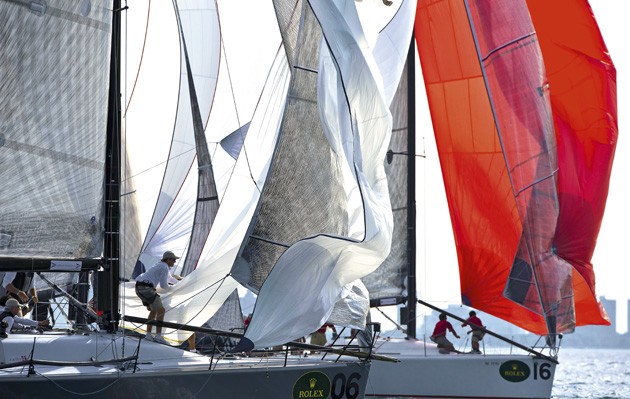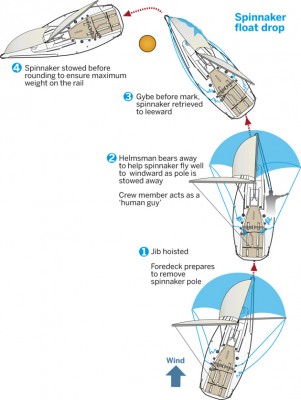This spinnaker gybe gives you more options at the leeward mark, especially if you’re under pressure. Successful owner Adam Gosling, reveals his five tips for a timely float drop
While a conventional spinnaker drop (kite down and pole away) may seem the safe option at a leeward mark, when a gybe is needed to complete the rounding a float drop can save you valuable seconds.
By removing the spinnaker pole, it allows the foredeck to be cleared ready for the gybe, then relies on the helmsman and trimmers to keep the free-flying spinnaker filled until the drop is called.
The scope for achieving a successful float drop is limited by wind direction and speed. It seldom works in very light conditions when you have to sail higher downwind angles to maintain boat speed. But with a bit more breeze and a true wind angle of more than 165° the spinnaker guy can be tripped off the pole end, then pushed outboard by one of the crew to help maintain the set – also known as the ‘human pole’.
After the float the spinnaker can be dropped on either side, the choice of which is usually driven by the preferred hoist at the next windward mark. But the decision also allows for a late call for either a port or starboard rounding at a leeward gate.
With an asymmetric kite, the term ‘Kiwi’ or ‘Mexican drop’ is often used for a situation in which the kite is doused on the new weather side while the boat goes through the gybe as the mark is rounded, thus also avoiding the risk of trawling the kite.
The upper wind limit for a float drop will be determined by crew experience and boat type; on lighter boats with tall rigs and large kites this must be judged against maintaining control at a busy mark rounding, so a few practice spinnaker runs and mark roundings without the pole will help establish what suits your boat and crew.
1. Timing to the mark
With five minutes to go to the bottom mark we like to have a plan pencilled in, with other options considered if there are many boats. A float drop allows this because it gives the tactician the opportunity for a late call depending on position and overlaps with other boats. Our pitman manages the crew and tells the tactician when we’ve no more options.
2. The human pole
During the last few minutes of the downwind leg the helmsman must position the boat on a deep run, so you can fly the spinnaker without the pole and then one of the crew (the mast man or navigator perhaps) can become the human pole. Remember, they have to keep their torso inside the line of the guardwires to stay legal within the rules (see RRS 49.2).
3. Clear the foredeck
With the pole stowed and the bow clear, the jib can be hoisted. In fact, it can be hoisted before the pole is stowed, but watch out for a forestay wrap if running square – pull some jib sheet on to prevent this.
The spinnaker can be taken down on either side, ideally so it and the gear is ready for the next run; if you are unsure, drop it to leeward ready for the gybe at the mark. The helmsman now dips the boat further down and calls the drop to allow the spinnaker to float into the boat, then focuses on steering round the mark, with all crew on the rail hiking hard.
4. Avoid the trawl
I can’t think why you would go around the bottom mark with the spinnaker up intentionally, so time it well and have the crew on the rail hiking as you round the mark. Late drops can save seconds, but a spinnaker in the water can cost you minutes.
If a mistake happens, keep focused, sort it out and get back into the race.
5. Know your job
To ensure success there has to be good communication between the helmsman and bowman. Make sure that everyone understands exactly what is happening and knows their job. Learn how long every manoeuvre will take and avoid calls like ‘somebody be the human pole’ at the last moment – identify that person by name.
What happens up front can be a bit of a black art. I have been lucky to have some of the best people on the bow with me. A helmsman needs to trust them and work with them, so practise, and learn the techie language that bowmen use (see 5 tips: bowmen signals for a few clues).
Adam Gosling has had a succession of successful racing boats called Yes! He was overall Black Group winner at Cowes for the second time in 2013 (see how he breathed new life into his latest Yes! and also his tips for Cowes Week here)





